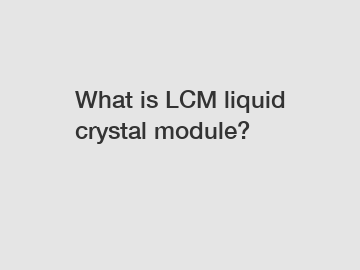What is LCM liquid crystal module?
Link to dgdz
What is LCM Liquid Crystal Module?
Google Hot Topics:

1. What is a LCM liquid crystal module?
2. How does a LCM liquid crystal module work?
3. Applications and uses of LCM liquid crystal modules.
4. Differences between LCM liquid crystal modules and other display technologies.
A liquid crystal module, commonly known as LCM, is an essential component in various electronic devices that require visual displays. LCMs are widely used in consumer electronics, automotive, medical equipment, industrial control systems, and many other applications. But what exactly is an LCM liquid crystal module? How does it work? And what are its applications and differences compared to other display technologies? Let's explore these hot topics around LCM liquid crystal modules.
1. What is a LCM liquid crystal module?
LCM liquid crystal module refers to a display module that utilizes liquid crystals to control the passage of light, creating images or texts on a screen. Liquid crystals are a unique state of matter that has properties between those of solids and liquids. They have the ability to manipulate the polarization of light passing through them, allowing for the creation of visually appealing displays.
2. How does a LCM liquid crystal module work?
LCM liquid crystal modules consist of several key components, including a backlight, polarizers, control circuitry, and the liquid crystal layer itself. When an electrical charge is applied to the liquid crystal layer, the molecules align in a specific orientation, altering the polarization of light passing through them. This polarization change creates the desired image on the screen. The control circuitry controls the voltage applied to different areas of the liquid crystals, enabling the precise manipulation of the displayed content.
3. Applications and uses of LCM liquid crystal modules.
LCM liquid crystal modules find extensive use across various industries due to their versatility and flexibility. Some common applications include:
a) Consumer Electronics: LCMs are widely used in smartphones, tablets, laptops, and televisions to provide vibrant and high-resolution displays for an immersive visual experience.
b) Automotive Industry: LCM liquid crystal modules are integrated into dashboards, infotainment systems, and heads-up displays in vehicles, enabling drivers to access crucial information easily.
c) Medical Equipment: LCMs are essential in medical devices like ultrasound machines, patient monitors, and diagnostic equipment, providing clear and detailed visuals for healthcare professionals.
d) Industrial Control Systems: LCM liquid crystal modules are utilized in industrial control systems and automation equipment to display real-time data, status information, and graphical interfaces for efficient monitoring and control.
4. Differences between LCM liquid crystal modules and other display technologies.
While LCM liquid crystal modules are widely used, they are not the only display technology available. Understanding the differences between LCMs and other technologies can help in making informed choices for specific applications. Here are a few variations:
a) OLED Displays: Organic Light-Emitting Diode (OLED) displays offer better contrast, faster response times, and thinner profiles compared to LCMs. Additionally, OLEDs do not require a backlight, resulting in energy savings. However, LCMs are more cost-effective for larger display sizes.
b) E-ink Displays: Electronic Ink (E-ink) displays are designed for low-power consumption applications, such as e-readers, electronic shelf labels, and smartwatches. Unlike LCMs, E-ink displays do not emit light and provide a paper-like reading experience, but they have limited color capabilities and slower refresh rates.
c) LED Displays: Light-Emitting Diode (LED) displays are commonly seen in outdoor advertising displays, traffic signs, and large video walls. LED displays have high luminosity, making them suitable for outdoor applications. However, their resolution might be lower compared to LCMs for smaller screens in consumer devices.
In conclusion, the versatile and widely used LCM liquid crystal modules play a vital role in the display technology industry. They offer high-resolution, vibrant visuals for numerous applications ranging from smartphones and TVs to automotive and medical equipment. While alternatives such as OLED displays, E-ink displays, and LED displays exist, LCMs continue to be a cost-effective and reliable choice for many devices. Whether you're enjoying a movie on your smartphone or monitoring vital signs in a hospital, there's a good chance that an LCM liquid crystal module is at work, delivering visual content with precision and clarity.
Click here to get more.
If you are looking for more details, kindly visit energy meter lcd display.



